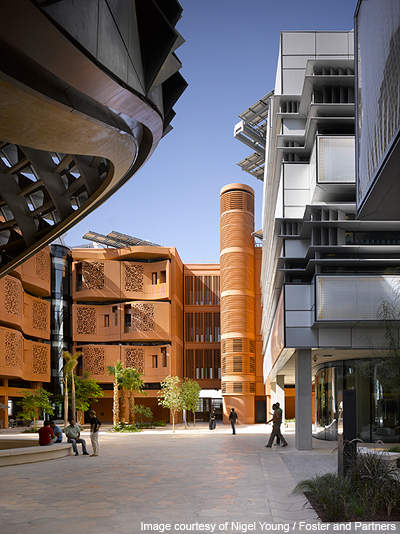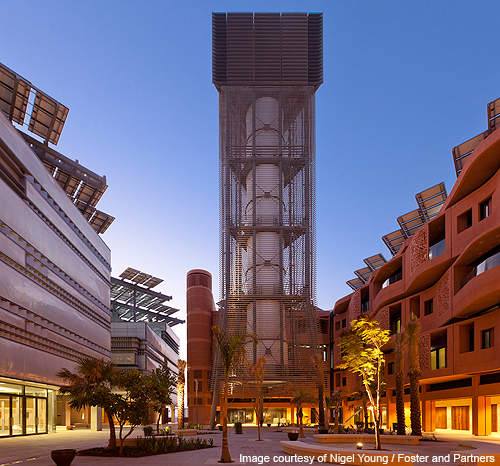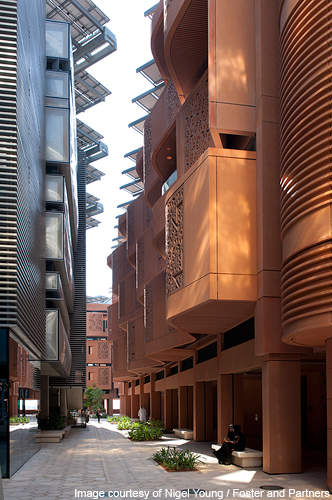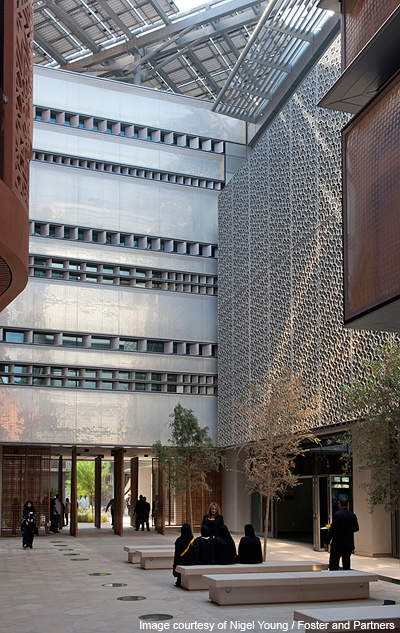The Masdar Institute of Science and Technology (MIST) is a new campus building at the new Masdar City in Abu Dhabi, UAE. The $500m campus is the first completed project of the proposed sustainable urban development.
MIST was established in cooperation with the Massachusetts Institute of Technology (MIT). The research-based institute offers graduate programmes in the field of renewable energy and clean environmental technologies. A Fosters + Partners-led consortium has designed the Masdar City master plan. RW Armstrong was the architect of MIST campus.
The education institute is being developed in phases with a total planned area of 343,740m². Construction of phase 1A of the MIST campus was started in 2007 and completed in January 2010.
Six buildings with 63,174m² of space were inaugurated in November 2010. The MIST campus won the RIBA (Royal Institute of British Architecture) International Award in May 2011 for its design.
Campus expansion under phase 1B was started in January 2011. The construction is scheduled for completion in the third quarter of 2012. The built-up area of the expansion will be 86,138m².
Masdar City master plan
Being developed 17km from Abu Dhabi, Masdar City will be one of the most sustainable cities in the world. The 6km² Masdar City project is being developed by the non-for-profit organisation Mubadala Development Company. It will be a compact, high-density, mixed-use development with zero-carbon emissions.
The pedestrian-focused community will accommodate about 40,000 residents and attract about 1,500 of global cleantech industry and renewable energy businesses.
The city is planned to include renewable and sustainable technologies to support the working and residential communities.
The original city development as per the master plan in 2007 was estimated to cost $22bn. It was scheduled for completion in 2016. The global economic crisis, however, necessitated few modifications decreasing the projected cost to about $19.8bn. The project completion has also been postponed to 2025.
Masdar Institute design
The campus has low-rise, high density residential buildings. They are designed to contrast the laboratory buildings. The buildings are designed to for optimum shade and require less energy for cooling. The buildings are built on a platform 7.62m above the desert level. The shaded colonnades decrease the impact of the exposed thermal mass. The perforated façades are also oriented to shade buildings and pedestrian streets.
Pedestrian paths and landscaping provide a civic realm within the city. A traditional Arabic Windtower in the central courtyard of the campus draws cool breeze to the ground. The 45m-tall steel structure is an architectural icon and a landmark of MIST neighbourhood. It will also be used to measure weather and test air quality. The public spaces between the residential and laboratory buildings are naturally ventilated and cooled by the windtower.
Other facilities include a gymnasium, meeting space, café and canteen. The rooftops are installed with photovoltaic systems, which provide 30% of the building’s energy requirement.
Façade
The glazed façade on the concrete frame buildings mitigate the internal transfer of heat. They are also sealed to reduce energy required for internal cooling. Façade of the laboratory has windows to allow daylight and external views. They are shaded with fins to eliminate the angled sunlight.
The solid areas are clad in thin aluminium and silver frit patterns to reflect light to the pedestrian streets. The mashrabiya type, screen-shielded apartment windows allow maximum natural light from the internal atrium and outside while also providing privacy. They are coloured in local sand to give the desert context and reduce maintenance. The helmet-shaped Knowledge Centre (library) is clad in flat and folded zinc for providing ventilated shading.
Landscaping
Native plants and strategically located water features across the campus provide a cool and relaxing environment in the public spaces. The series of street spaces and courtyards have been designed with different regional themes. Recycled water is used for irrigation of the plants.
Sustainability
The science and technology institute is powered by a 10MW solar PV plant built by Enviromena Power Systems. The PV modules on a 22ha-site on the Masdar City boundary are the largest in the Middle East. The buildings are fitted with water efficient fixtures, smart water reduction and monitoring technologies and efficient laundry systems. The wastewater, recycled at the city’s treatment plant, is also reused for irrigation. The project used special concrete mixtures and sustainable forest woods to reduce carbon emissions.
The campus will use electric-powered Personal Rapid Transit (PRT) vehicles for transport. The driver-less cars can travel at speeds of about 40kph. The institute uses 51% less power and 54% less potable water than a typical UAE building.
MIST facilities
Phase 1A of the MIST campus was opened with four residential blocks comprising 102 apartments and two laboratory buildings and other amenities. Phase 1B will add another three blocks and 221 apartments, another three laboratory buildings, a performance hall, sports facility, a 90-seat multipurpose hall for cultural, sports and musical events, 13 hi-bay laboratories and two cleanrooms, and an open-air swimming pool. The campus will provide education for about 600 to 800 students.
Contractors
Al Ahmadiah Contracting & Trading and Hip Hing Construction Company is the main contractor for the phase 1A. In November 2010, Arabian Construction Company was awarded a $205m contract for the phase 1B project.











